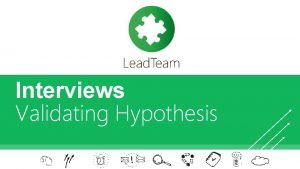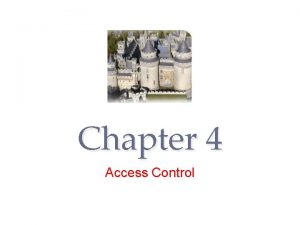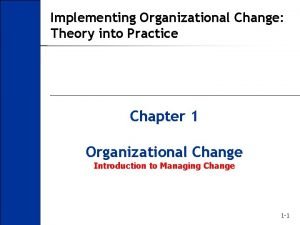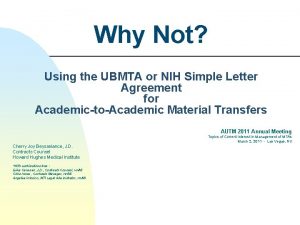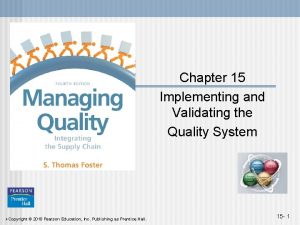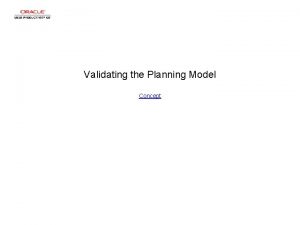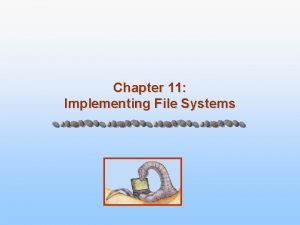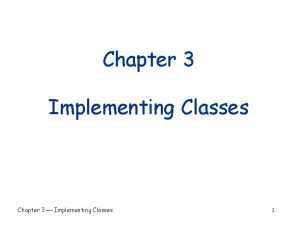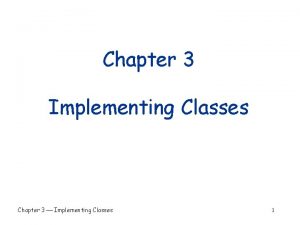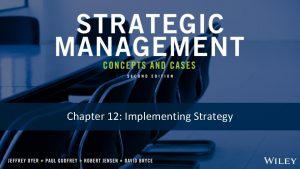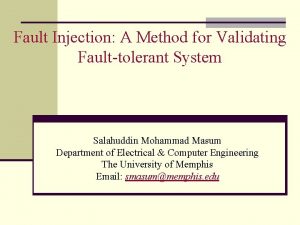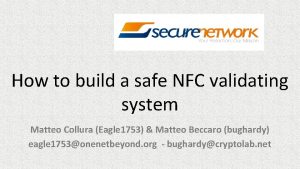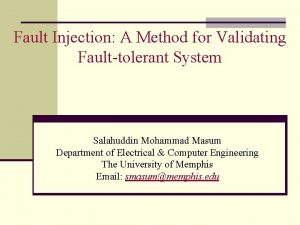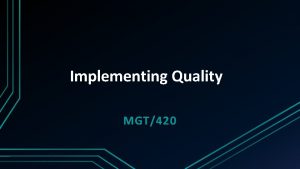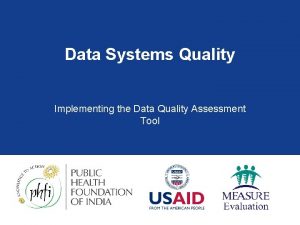Chapter 14 Implementing and Validating the Quality System



























































- Slides: 59

Chapter 14 Implementing and Validating the Quality System S. Thomas Foster, Jr. Boise State University Slides Prepared by Bruce R. Barringer University of Central Florida © 2001 Prentice-Hall

Chapter Overview • Building Blocks for the System of Quality Improvement • Internal Validation: Documenting and Assessing the Quality System • Quality Audits • Externally Validating the Quality System © 2001 Prentice-Hall Transparency 14 -2

Introduction • When you reach best-in-class or best-in-the-world status, how do you get beyond that point? • If you have reached the limit of your knowledge and yet feel that more improvement can be made, how do you determine the next step? • Answering these questions is the goal of this chapter. © 2001 Prentice-Hall Transparency 14 -3

Introduction • World-class competitors were good at performing the fundamentals. • World-class performers have a good understanding of where they are and where they want to be. © 2001 Prentice-Hall Transparency 14 -4

Building Blocks for the System of Quality Improvement • A quality system depends on the interactions of many different variables. • Figure 14. 1 shows a quality system model containing many different variables. • Quality improvement requires the interactions of many different disciplines to create products, services, processes, and systems that effectively serve customers. © 2001 Prentice-Hall Transparency 14 -5

Building Blocks for the System of Quality Improvement • Figure 14. 1 Quality system model © 2001 Prentice-Hall Transparency 14 -6

Building Blocks for the System of Quality Improvement Slide 1 of 5 People For a quality system to function effectively, employees must understand that they are integral to that system. © 2001 Prentice-Hall Organizational Learning and Knowledge Learning needs assessment, training design, and delivery of training are important for competitiveness. Transparency 14 -7

Building Blocks for the System of Quality Improvement • People -- The model in Figure 14. 1 is built on a base of people. -- People represent the core of a firm’s capabilities because they provide the intellect, empathy, and ability that is required to provide outstanding customer service. -- System must be in place to develop, train, and motivate people to serve the customer properly. © 2001 Prentice-Hall Transparency 14 -8

Building Blocks for the System of Quality Improvement • People -- For a quality system to function effectively, employees must understand that they are integral to that system. -- They must be made to feel important and necessary for the continual survival and growth of the company. -- Another people-related issue involves corporate restructure and reengineering. © 2001 Prentice-Hall Transparency 14 -9

Building Blocks for the System of Quality Improvement • People -- Quality improvement efforts, when performed properly, are associated with improved moral and improved confidence among employees that company is becoming more competitive and the employees’ personal security is improving. -- Many managers forget that human beings desire security. -- Some employees will forego higher wages in order to achieve higher job security. © 2001 Prentice-Hall Transparency 14 -10

Building Blocks for the System of Quality Improvement • Organizational Learning and knowledge -- Knowledge is the capital that fuels outstanding quality results. -- Learning need assessment, training design, and delivery of training are important for competitiveness. -- Outstanding customer service results from providing employees with outstanding knowledge and training. © 2001 Prentice-Hall Transparency 14 -11

Building Blocks for the System of Quality Improvement Slide 2 of 5 Culture Companies that respond quickly to customers’ needs have cultures where decision making is open, information is available to everyone, and risks are rewarded. © 2001 Prentice-Hall Closeness to Customers Closeness to customers describes the firm’s understanding of the customers, their needs, and their wants. Transparency 14 -12

Building Blocks for the System of Quality Improvement • Culture -- Culture refers to the norms and beliefs that lead to decision-making patterns and actions in an organization. -- Some of the key aspects of culture include attitudes toward changes; presence or absence of fear; degree of openness, fairness, and truth; and employee behavior at all levels. -- Companies that respond quickly to customers’ needs have cultures where decision making is open, information is available to everyone, and risks are rewarded. © 2001 Prentice-Hall Transparency 14 -13

Building Blocks for the System of Quality Improvement • Closeness to customer -- Closeness to customers describes the firm’s understanding of the customers, their needs, and their wants. -- Note that the building block “ Closeness to customer” is built on people, organizational learning and knowledge, and culture. -- For customer closeness to be achieved, systems must be put in place for gathering data about customers, analyzing the data, and implementing change systems based on the analysis. Transparency 14 -14 © 2001 Prentice-Hall

Building Blocks for the System of Quality Improvement • Closeness to customer -- Not only is an understanding of customers required, but also an understanding of the competitor’s customers. -- Customer closeness engenders loyalty. -- Brand loyalty may become less important as time passes and consumers move to an ethos where product choices are valued over brand. -- In this environment, personal relationships between vendors, suppliers, and customers become important differentiators. © 2001 Prentice-Hall Transparency 14 -15

Building Blocks for the System of Quality Improvement • Closeness to customer -- The level of customer contact achieved in service requires an understanding not only of customers’ current wants but also of their emerging wants. -- An understanding of the types of customers that a firm will serve and a focus on key capabilities are important in determining to which customers a firm should become close. © 2001 Prentice-Hall Transparency 14 -16

Building Blocks for the System of Quality Improvement Slide 3 of 5 Information and Finance Information systems provide the core of the support systems for satisfying the customer. © 2001 Prentice-Hall Transparency 14 -17

Building Blocks for the System of Quality Improvement • Information and finance -- Information systems provide the core of support system for satisfying the customer. -- Well-designed information systems, such as described at Ritz-Carlton hotels ( see Quality Highlight 8. 1 on page 229), become the institutional memory for customer needs. -- If information systems are not well designed and information is difficult or slow to obtain, customers will go elsewhere. © 2001 Prentice-Hall Transparency 14 -18

Building Blocks for the System of Quality Improvement • Information and Finance -- EDI is of increasing importance for satisfying customer needs. -- The objective of a quality information system is to gather information relating to the key variables that affect customer service and product quality. -- The scope of the information system includes the entire organization, linkages to customers, and linkages to suppliers. -- The action required to make the information system effective are problem identification, analysis, and corrective action. © 2001 Prentice-Hall Transparency 14 -19

Building Blocks for the System of Quality Improvement • Information and Finance -- Financial resources are needed to provide the infrastruture and services that customers want. -- Most firm that are world-class examples of quality are also financially successful. -- High quality can improve bottom-line results and enhance financial stability. -- Finance is a two-way street. Companies that are financially successful are able to invest in systems that will satisfy customers; and high-quality processes, products, and services lead to financial success. © 2001 Prentice-Hall Transparency 14 -20

Building Blocks for the System of Quality Improvement Slide 4 of 5 Three Spheres of Quality planning and management Quality assurance © 2001 Prentice-Hall Quality Control Transparency 14 -21

Building Blocks for the System of Quality Improvement Slide 5 of 5 • Notice that they are closely related to enterprise capabilities and customer service. -- Enterprise capabilities – Are those capabilities firms have that make them unique and attractive to customers. -- Customer service – Is both a goal and an outcome of system. © 2001 Prentice-Hall Transparency 14 -22

Building Blocks for the System of Quality Improvement • The Interactive Approach -- The integrative systems view recognizes that all the building blocks must be in place in all the functional areas and throughout all levels of the organization for quality improvement to be both horizontally and vertically deployed in worldclass companies. © 2001 Prentice-Hall Transparency 14 -23

Building Blocks for the System of Quality Improvement • Alignment between the Quality System and Strategy -- The design of the quality system must have focus. -- A strategy framework is necessary to achieve this focus, which means that the design of the quality system must be in alignment with the strategic objectives and plans of the organization. -- Hoshin planning or policy deployment provides a framework for achieving alignment through the catchball process. © 2001 Prentice-Hall Transparency 14 -24

Internal Validation: Documenting and Assessing the Quality System • Once a quality system has been established, the system must be allowed to operate effectively over time. • The goal of self-assessment is to observe current practices, to assess those practices, and to identify gaps in deployment. • Figure 14. 2 shows a generic process for performing self-assessment in a four-step process of surveying, categorizing, investigating, and evaluating. © 2001 Prentice-Hall Transparency 14 -25

Internal Validation: Documenting and Assessing the Quality System • Figure 14. 2 Internal environmental analysis process © 2001 Prentice-Hall Transparency 14 -26

Internal Validation: Documenting and Assessing the Quality System Slide 1 of 2 • Four Step Self Assessment Process – Step 1: Surveying • Generate long-list of strengths and weaknesses from primary and support activities of the firm’s value chain. © 2001 Prentice-Hall Transparency 14 -27

Internal Validation: Documenting and Assessing the Quality System • Four Step Self Assessment Process – Step 2: Categorizing • Re-conceptualize long-list in terms of resources and capabilities and complete deeper inspection with the application of key questions. © 2001 Prentice-Hall Transparency 14 -28

Internal Validation: Documenting and Assessing the Quality System Slide 2 of 2 • Four Step Self Assessment Process – Step 3: Investigating • Determine where, along the firm’s value chain, potential competitive advantage lies. Look at each competitively relevant resource and capability relative to its potential as a cost or uniqueness driver. © 2001 Prentice-Hall Transparency 14 -29

Internal Validation: Documenting and Assessing the Quality System • Four Step Self Assessment Process – Step 4: Evaluating • Choose the appropriate generic strategy for the firm - cost leadership , differentiation, and focus. © 2001 Prentice-Hall Transparency 14 -30

Quality Audits • Quality Audits – The approach to auditing used in ISO 9000 has not yet achieved general acceptable as a useful model for internal assessment. – There a number of different approaches to auditing company systems. – We should first define what we mean by audits. – These are audits that can be defined as an internal assessment tool to identify areas for improvement. © 2001 Prentice-Hall Transparency 14 -31

Quality Audits • Quality Audits – Study ways to improve customer service and to ascertain whether current customer service processes are being performed. • Audit Process – The audit process is based on a framework of standards, concepts, procedures, and reporting practices. The steps in a quality audit are shown on Figure 14. 3. © 2001 Prentice-Hall Transparency 14 -32

Quality Audits Slide 2 of 4 Figure 14. 3 Generic Auditing Steps Familiarization Verification Evaluation Recommendation © 2001 Prentice-Hall Transparency 14 -33

Quality Audits • Intuition alone does not constitute a sufficient conceptual basis for a proper audit. • In-depth knowledge of auditing standards, proper establishment of audit objectives, carefully planned audit procedures, controlled execution of audit steps, and disciplined adherence to proper auditing methods in arriving at conclusions are all requisite for accurate audits. • An audit must be designed and conducted to gather all the facts relevant to the matter in question, weighing the “good” against the “bad. ” © 2001 Prentice-Hall Transparency 14 -34

Quality Audits Slide 3 of 4 • There are three main ingredients to an audit – Auditing principle • Is a fundamental truth, primary law, or doctrine. • It does constitute a rule that is derived from reasoning and experience. • It indicate the objective of auditing. • It suggest the manner in which the objectives are achieved. • It constitute the basis for the application of audit procedures to a logical manner. © 2001 Prentice-Hall Transparency 14 -35

Quality Audits • There are three main ingredients to an audit – Auditing standard • Is a measurement of performance or a criterion establishing professional authority and consent. • A standard is a performance-measuring device. © 2001 Prentice-Hall Transparency 14 -36

Quality Audits • There are three main ingredients to an audit – Auditing procedure • Establishes the courses of action available to the auditor to judge the adherence to the standards and the validity of the application of the principles. • Although auditing concepts and methods are not as rigid as methods in the physical sciences, there is a similarity. • In auditing there is evidential support for every conclusion. • An “audit-scientific” method should be developed and followed. © 2001 Prentice-Hall Transparency 14 -37

Quality Audit Process Slide 4 of 4 Steps of basic quality audit Preparation Audit team selection Develop checklists The opening meeting The exit meeting Reporting and corrective action Follow-up Analysis © 2001 Prentice-Hall Implementing the audit Closure Transparency 14 -38

Types of Audits Operational Audits Performance Audits Certification Audits Award Audits Consultant Audits Presidential Audits Qualitative Audits © 2001 Prentice-Hall Transparency 14 -39

Types of Audits Slide 1 of 5 • Operational Audits – Are directed towards improving the operations that are being studied. – Operational auditing is being used now frequently for services and government. – Operational audits represent the application of the talents, background, and techniques of the internal auditors to the operating controls that exist in the business. © 2001 Prentice-Hall Transparency 14 -40

Types of Audits • The general objective of the operational audit is to “assist all members of management in the effective discharge of their responsibilities by furnishing them with objective analyses, appraisals, recommendations, and pertinent comments concerning the activities reviewed. ” © 2001 Prentice-Hall Transparency 14 -41

Types of Audits • Performance Audits – There are several major types of performance audits. • Supplier audits are conducted by purchasers of their suppliers. • In the automotive industry, these are conducted using the QS 9000 standards. • Periodic audits are then performed to endure that the suppliers is maintaining standards and to improve the performance of the suppliers. • This approach is referred to as supplier © 2001 Prentice-Hall Transparency 14 -42 development.

Types of Audits • Performance Audits – There are several major types of performance audits (continued). • Certification audits are used to maintain a certification such as ISO 9000 or ISO 14000. • These audit focus on the documentation of systems and adherence to those standards. © 2001 Prentice-Hall Transparency 14 -43

Types of Audits Slide 2 of 5 • Performance Audits – Types of performance audits (continued) • Award audits such as the Baldrige, state quality awards, customer awards, and other prizes involve site visits to externally validate the claims made by applicants in their applications. • These visits exist to clarify and verify the information that has been provided by the applicant. © 2001 Prentice-Hall Transparency 14 -44

Types of Audits • Performance Audits – Types of performance audits (continued) • Consultant audits are studies performed by consultants to determine the maturity of a company in the quality pursuit and to help identify areas to be addressed in future quality plans. • These are sometimes called quality maturity studies. © 2001 Prentice-Hall Transparency 14 -45

Types of Audits Slide 3 of 5 • Performance Audits – Types of performance audits (continued) • Presidential audits performed by a team led by the president of the company. These audits are usually operational and quality-related in focus. • This gets the president of the firm actively involved in the quality audits and design of the quality system • During a presidential audit, the questions in Table 14. 2 are asked. © 2001 Prentice-Hall Transparency 14 -46

Types of Audits • Table 14. 2 Questions to be answered in a presidential audit © 2001 Prentice-Hall Transparency 14 -47

Types of Audits – Presidential audits • In these audits, an overall assessment of the organization is performed, and this information is inserted into the following year’s strategic plans. • Kaoru Ishikawa was an advocate of presidential audits. • Table 14. 3 shows expected benefits of presidential audits as Kaoru Ishikawa defined them. • A closer look at quality 14. 1 show the quality audit in action. © 2001 Prentice-Hall Transparency 14 -48

Types of Audits • Table 14. 3 Benefits of presidential audits © 2001 Prentice-Hall Transparency 14 -49

Types of Audits Slide 5 of 5 • Qualitative and Quantitative Audits – Some audits have more of a quantitative flavor when focusing on issues such as conformance and quality control. – Cost-of-quality audits may be conducted to determine whether quality costs are lessening and the programs are working. © 2001 Prentice-Hall Transparency 14 -50

Types of Audits • Qualitative and Quantitative Audits – Qualitative audits compare current practice against structural measures. – Structural measures are the documents relating to processes. – These include standards, contracts, procedures, regulatory requirements, and hierarchical standards. – In qualitative audits, studies are performed to see that procedures are being followed. © 2001 Prentice-Hall Transparency 14 -51

Externally Validating the Quality System Slide 1 of 3 • External Validation – Using someone from the outside to study a firm’s quality systems and identify areas for improvement. – The strength of the Baldrige criteria is its applicability as an assessment tool. © 2001 Prentice-Hall Transparency 14 -52

Externally Validating the Quality System • Self Assessment – Figure 14. 5 shows a model of the selfassessment process using the Baldrige criteria. © 2001 Prentice-Hall Transparency 14 -53

Externally Validating the Quality System Slide 2 of 3 Figure 14. 5 Self Assessment Process Establish a purpose Make a plan Collect data Document findings Establish strengths and areas for improvement Develop improvement strategy © 2001 Prentice-Hall Transparency 14 -54

Externally Validating the Quality System • After evaluating the reports, the examiners write responses to the evaluation document outlining areas that should be improved. • Figures 14. 6 through 14. 8 show examples of the type of feedback received. • The first feedback is the overview. • Next feedback is provided for each of the Baldrige categories. • The most useful information for improvement comes from the areas for improvement items. • The feedback reports provide very specific areas for improvement. © 2001 Prentice-Hall Transparency 14 -55

Externally Validating the Quality System • Figure 14. 6 Example of a Baldrige summary © 2001 Prentice-Hall Transparency 14 -56

Externally Validating the Quality System • Figure 14. 7 Item 1. 1 example of a feedback report © 2001 Prentice-Hall Transparency 14 -57

Externally Validating the Quality System • Figure 14. 8 Item 1. 2 example of a feedback report © 2001 Prentice-Hall Transparency 14 -58

Externally Validating the Quality System Slide 3 of 3 • State Quality Awards – State quality awards can provide a low-cost means of using the Baldrige criteria in firms. – There are currently 44 state quality awards. – More than 1, 000 companies annually apply for state quality awards, and most of the award programs are Baldrige based. American firms can also apply for the Japanese Deming Prize. – State quality awards allow companies to receive external reviews for a nominal cost. © 2001 Prentice-Hall Transparency 14 -59
 Validating hypothesis
Validating hypothesis Management issues central to strategy implementation
Management issues central to strategy implementation Implement strategies management issues
Implement strategies management issues Chapter 7 strategic management
Chapter 7 strategic management Setting prices and implementing revenue management
Setting prices and implementing revenue management Toyota brand hierarchy
Toyota brand hierarchy Designing and implementing branding strategies
Designing and implementing branding strategies Crm vision statement examples
Crm vision statement examples Strategic business unit structure
Strategic business unit structure Brand hierarchy tree
Brand hierarchy tree Ch 7
Ch 7 Quality assurance vs quality control
Quality assurance vs quality control Basic concept of quality management
Basic concept of quality management Hrd program implementation
Hrd program implementation Retail management notes doc
Retail management notes doc Characteristics of portfolio assessment
Characteristics of portfolio assessment Qsen teamwork and collaboration
Qsen teamwork and collaboration Challenges of implementing predictive analytics
Challenges of implementing predictive analytics Bert spector
Bert spector Finance and accounting issues in strategy implementation
Finance and accounting issues in strategy implementation Access rights definition
Access rights definition Keys to successful project portfolio management
Keys to successful project portfolio management Implementing nfpa 1600 national preparedness standard
Implementing nfpa 1600 national preparedness standard Implementing organizational change theory into practice
Implementing organizational change theory into practice Ubmta signatories
Ubmta signatories Emap
Emap Implementing firewall technologies
Implementing firewall technologies Quality management pmp
Quality management pmp Quality metrics pmp
Quality metrics pmp Total quality management seminar
Total quality management seminar Compliance vs quality
Compliance vs quality Philip crosby formulated the seven deadly diseases
Philip crosby formulated the seven deadly diseases Crosby's fourteen steps to quality improvement
Crosby's fourteen steps to quality improvement What is tqm
What is tqm Hình ảnh bộ gõ cơ thể búng tay
Hình ảnh bộ gõ cơ thể búng tay Slidetodoc
Slidetodoc Bổ thể
Bổ thể Tỉ lệ cơ thể trẻ em
Tỉ lệ cơ thể trẻ em Chó sói
Chó sói Thang điểm glasgow
Thang điểm glasgow Hát lên người ơi
Hát lên người ơi Kể tên các môn thể thao
Kể tên các môn thể thao Thế nào là hệ số cao nhất
Thế nào là hệ số cao nhất Các châu lục và đại dương trên thế giới
Các châu lục và đại dương trên thế giới Công thức tính thế năng
Công thức tính thế năng Trời xanh đây là của chúng ta thể thơ
Trời xanh đây là của chúng ta thể thơ Cách giải mật thư tọa độ
Cách giải mật thư tọa độ Phép trừ bù
Phép trừ bù Phản ứng thế ankan
Phản ứng thế ankan Các châu lục và đại dương trên thế giới
Các châu lục và đại dương trên thế giới Thể thơ truyền thống
Thể thơ truyền thống Quá trình desamine hóa có thể tạo ra
Quá trình desamine hóa có thể tạo ra Một số thể thơ truyền thống
Một số thể thơ truyền thống Cái miệng nó xinh thế
Cái miệng nó xinh thế Vẽ hình chiếu vuông góc của vật thể sau
Vẽ hình chiếu vuông góc của vật thể sau Thế nào là sự mỏi cơ
Thế nào là sự mỏi cơ đặc điểm cơ thể của người tối cổ
đặc điểm cơ thể của người tối cổ V cc cc
V cc cc Vẽ hình chiếu đứng bằng cạnh của vật thể
Vẽ hình chiếu đứng bằng cạnh của vật thể Vẽ hình chiếu vuông góc của vật thể sau
Vẽ hình chiếu vuông góc của vật thể sau
